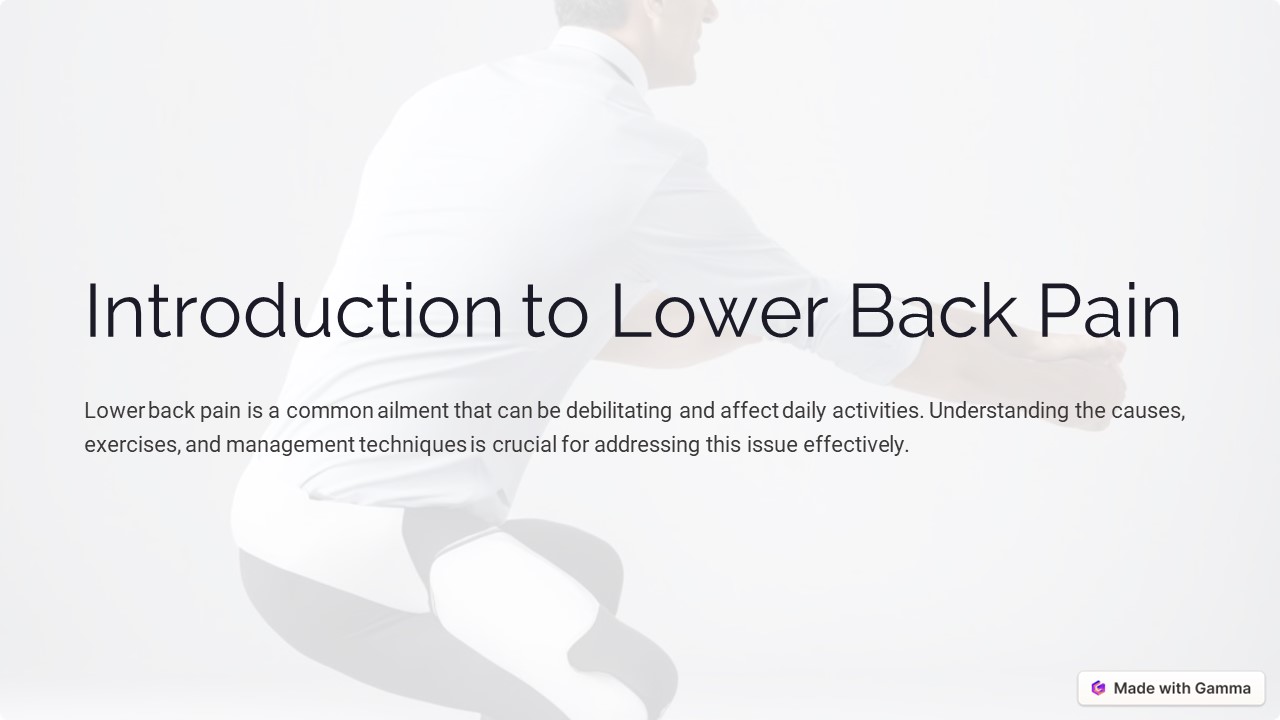Introduction to Lower Back Pain - PowerPoint PPT Presentation
Title:
Introduction to Lower Back Pain
Description:
The causes of lower back pain can vary from poor posture and muscle strain to more serious conditions such as herniated discs or arthritis. Identifying the specific cause is essential for determining an appropriate course of action. – PowerPoint PPT presentation
Number of Views:0
Title: Introduction to Lower Back Pain
1
Introduction to Lower Back Pain
Lower back pain is a common ailment that can be
debilitating and affect daily activities.
Understanding the causes, exercises, and
management techniques is crucial for addressing
this issue effectively.
2
Causes of Lower Back Pain
The causes of lower back pain can vary from poor
posture and muscle strain to more serious
conditions such as herniated discs or arthritis.
Identifying the specific cause is essential for
determining an appropriate course of action.
Poor Posture
Muscle Strain
Underlying Conditions
Inactive lifestyle or prolonged sitting can
contribute to lower back discomfort.
Heavy lifting or sudden movements can lead to
muscle-related back pain.
Conditions like arthritis or spinal stenosis can
also cause lower back pain.
3
Importance of Exercise in Managing Lower Back Pain
Exercise is crucial for managing and preventing
lower back pain. It helps strengthen the back and
core muscles, improves flexibility, and promotes
better posture.
Strengthens Muscles
Improves Flexibility
1
2
Regular exercise helps build strong and
supportive muscles in the back and abdomen.
Stretching and range of motion exercises enhance
flexibility, reducing the risk of strain.
4
The Single Best Exercise for Lower Back Pain
The cat-cow stretch is often regarded as one of
the most effective exercises for alleviating
lower back pain. It targets the entire spine and
engages the core muscles, providing relief and
promoting flexibility.
Targeted Spinal Stretch
Core Activation
1
2
The gentle, flowing movement of the cat-cow
stretch releases tension and improves spinal
flexibility.
Engaging the abdominal muscles during this
exercise helps support the lower back.
5
How to Perform the Exercise Correctly
Start on your hands and knees, with a neutral
spine. As you inhale, arch your back like a cat,
and as you exhale, lift your chest and tailbone
like a cow. Repeat this sequence slowly and
fluidly, synchronizing breath with movement.
1
2
Inhale
Exhale
Arch your back upwards like a stretching cat.
Lift your chest and tailbone, resembling the
posture of a cow.
6
Modifications for Different Levels of Fitness
For individuals with limited flexibility,
performing the cat-cow stretch on a yoga block or
using a bolster may provide added support.
Adjusting the pace and range of motion is also
beneficial for those with varied fitness levels.
Use Props
Adapt Pace
Enhance comfort and stability by incorporating
props like yoga blocks or blankets.
Modify the speed of movement to match your
current flexibility and comfort level.
7
Frequency and Duration of the Exercise
Perform the cat-cow stretch for 5-10 minutes, at
least once a day. Consistency is key for
experiencing the benefits of enhanced flexibility
and reduced lower back discomfort.
Frequency
1
Start with daily practice to establish a routine
and gauge its impact on your comfort and
flexibility.
Duration
2
Gradually increase the duration of the exercise
as your flexibility and comfort level improve.
8
Other Exercises That Can Complement the Single
Best Exercise
Exercises like pelvic tilts, knee-to-chest
stretches, and the child's pose can supplement
the benefits of the cat-cow stretch. These
exercises target specific areas of the lower back
and support overall spinal health.
Pelvic Tilts
Knee-to-Chest Stretches
Child's Pose
Engages the lower abdominal and pelvic muscles,
promoting stability and flexibility in the lower
back.
Stretches the muscles and ligaments of the lower
back and helps relieve tension and discomfort.
Relaxes the lower back and gently stretches the
spine and hips, promoting relaxation and
flexibility.
9
Conclusion and Additional Resources
Continuous effort and commitment to a regular
exercise routine can significantly alleviate
lower back pain and contribute to overall spinal
health. Seeking guidance from a healthcare
professional or physical therapist for
personalized recommendations is paramount.

